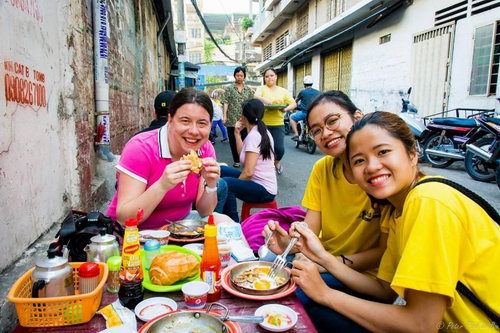|
|
You are
planning a trip to Vietnam and are having difficulties
deciding where to go and what to do, what you cannot miss
and what to skip. From the feedbacks of our customers,
Tailormade Vietnam Holidays would like to recommend some
activities considered by travellers as must-do's when you
are in Vietnam....
read more |
|
Eating in Vietnam
Eating in Vietnam is an incredible culinary
adventure, known for its fresh ingredients, vibrant flavors, and diverse
regional specialties. Here's a guide to help you navigate the delicious
world of Vietnamese cuisine:

Must-Try Dishes:
•
Phở (Noodle Soup): Vietnam's
iconic dish. You'll find it everywhere.
o
Phở b?? (beef pho): The most
common, with various cuts of beef.
o
Phở g?? (chicken pho): A lighter,
clearer broth.
•
B??nh M?? (Vietnamese Sandwich): A
delicious fusion of French and Vietnamese flavors, typically a crispy
baguette filled with various meats (pork, chicken, pate, cold cuts), pickled
vegetables, cilantro, and chili.
•
B??n Chả (Grilled Pork with Vermicelli):
A Hanoi specialty. Grilled pork patties and slices of marinated pork belly
are served with cold vermicelli noodles, a dipping sauce, and fresh herbs.
•
Gỏi Cuốn (Fresh Spring Rolls/Summer Rolls):
Light and refreshing rice paper rolls filled with shrimp, pork, vermicelli,
and fresh herbs, usually served with a peanut or nuoc cham (fish sauce)
dipping sauce.
•
B??nh X??o (Crispy Vietnamese Pancake):
A savory crepe made with rice flour, turmeric, and coconut milk, filled with
pork, shrimp, and bean sprouts. Eaten wrapped in lettuce and herbs with
dipping sauce.
•
B??n B?? Huế (Hue Beef Noodle Soup):
A spicy and flavorful noodle soup from Hue, with beef, pork, and thick rice
noodles in a broth flavored with lemongrass and chili.
•
Mi Quang (Quang Noodles): A
central Vietnamese noodle dish from Quang Nam province, known for its
minimal broth, turmeric-flavored noodles, shrimp, pork, and peanuts.
•
Cơm Tấm (Broken Rice): A popular
street food made from fractured rice grains, often served with grilled pork
chops, a fried egg, and pickled vegetables.
•
B??n Ri??u (Crab Noodle Soup): A
crab-based soup noodle dish with a tomato base, crab paste, and vermicelli
noodles, often with toppings like pork, tofu, and blood jelly.
•
C?? Ph?? Trứng (Egg Coffee): A
unique Hanoi specialty, a rich and creamy coffee drink topped with a whipped
egg yolk foam.
Where to Eat:
•
Street Food Stalls: This is where
you'll find the most authentic and often the most delicious food. Look for
stalls crowded with locals – it's a good sign of quality and freshness.
Don't be afraid to sit on the tiny plastic stools!
•
Local Restaurants (Qu??n): These
are often more established than street stalls but still offer local dishes
at affordable prices.
•
Mid-Range to Fine Dining: In
larger cities like Hanoi and Ho Chi Minh City, you'll find a growing number
of upscale restaurants offering modern interpretations of Vietnamese cuisine
or international fare. Some notable ones include:
o
Anan Saigon (Ho Chi Minh City):
Michelin-starred, offering a refined take on Vietnamese street food.
o
La Maison 1888 (Da Nang): A
fine-dining restaurant at InterContinental Da Nang Sun Peninsula Resort,
known for French cuisine with Vietnamese influences.
o
Morning Glory Signature (Hoi An):
Highly recommended for contemporary Vietnamese dishes.
o
Cuc Gach Quan (Ho Chi Minh City):
Known for traditional Vietnamese fare in a cozy setting.
Vietnamese Food Culture and Etiquette Tips:
•
Chopsticks are primary: While
forks might be available, chopsticks are the main utensil.
o Hold them towards the bottom.
o Avoid sticking them vertically into your rice bowl (it resembles incense
at funerals).
o Don't use them to spear food or point at others.
•
Communal Dining: Food is often
shared from common dishes.
o Use serving utensils if provided, or the reverse end of your chopsticks to
take food from communal plates.
o Place food in your small individual bowl before eating.
•
Respect Elders: Wait for the
oldest person to start eating before you begin.
•
Finish Your Food: It's considered
polite and respectful to finish everything on your plate, showing you
enjoyed the meal.
•
Condiments are Key: Vietnamese
tables often have a variety of condiments like fish sauce (nuoc cham), chili
sauce, garlic in vinegar, and fresh herbs. Customize your dish to your
liking!
•
Eat when locals do: To find the
freshest and best food, try to eat during peak local mealtimes (early for
breakfast, around noon for lunch, early evening for dinner).
•
Be Adventurous: Don't be afraid to
try new things, even if they look unfamiliar.
•
Payment: At street stalls, you
often eat first and pay later. The vendor will usually tally your bill
mentally.
Enjoy your culinary journey through Vietnam!
|
|
|


|